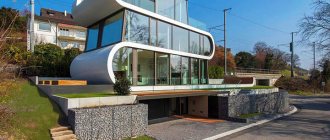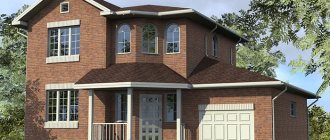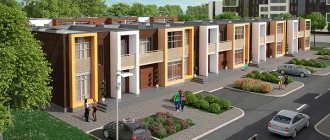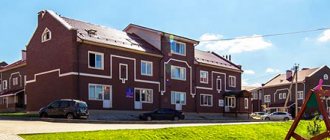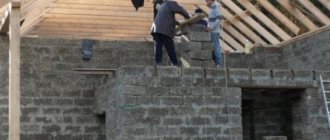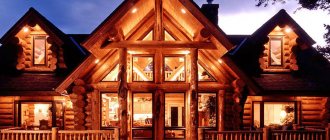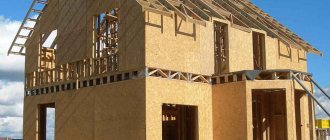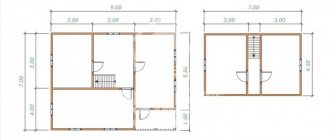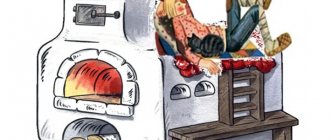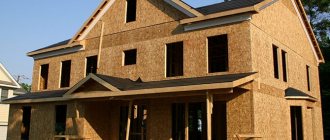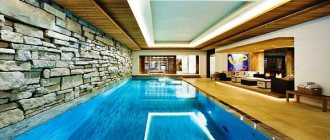Many people dream of a private home, because they so want to escape from the bustle of the city. But a private house is an expensive pleasure, which is due to the rising cost of building materials. Brick, natural wood, and stone are becoming increasingly unavailable for individual construction, so representatives of the construction industry and their clients were forced to search for more economical materials with similar characteristics. And they were found! High-quality, relatively light gas silicate
Today they are widely used for commercial and private construction.
Houses built from aerated concrete have an attractive appearance
, they
are resistant to temperature changes
, so they can be erected in regions with any type of climate. It is cool in such houses in summer and very warm in winter, so owners of aerated block houses will feel comfortable!
Houses have a number of characteristics, in some cases their quality exceeds the quality of buildings built from brick or wood. The porous structure of the material is the key to excellent thermal insulation
, resulting in good savings on heating costs. Gas silicate used in individual construction can be combined with other materials, which improves its performance characteristics.
Home selection
Advantages of gas silicate as a building material
Gas silicate blocks are a natural building material, a type of cellular concrete, and consist of a concrete mixture and silica sand. Manufacturers, to obtain larger volumes, heat the mixture to high temperatures. During the heating process, pores appear in the structure of the blocks. It is they who determine the main advantages of this material.
Gas silicate has low thermal conductivity. It does not let heat and cold into the house, so it is always cool in the summer and warm in the winter. Increased tightness of premises is achieved through the use of special adhesives.
The sound insulation of the material is also good. On average, the performance is 8 times better than that of brick. During construction, additional sound insulation may not be used.
Since gas silicate blocks are very light, they can be laid and moved independently without any problems. The light weight of the material also reduces foundation costs. Therefore, building cottages from gas silicate blocks is an economical and simple solution.
There is no need to use a drill to create small holes when working with gas silicate blocks: a nail or self-tapping screw can be easily driven into them. The drill is used only to create holes for sockets or communications. Thus, you can easily decorate the walls (hang pictures and other elements) and screw in furniture.
Gas silicate blocks absorb vapors and release them to the street, so the building will never feel stuffy or high humidity. Thanks to this feature, moisture is quickly removed from the premises, which reduces the risk of mold. For even greater reliability, you can waterproof it before erecting the first row of blocks. We recommend ordering gas silicate from the manufacturer here: https://belkirpich.ru.
Compound
Silicates are produced exclusively from natural ingredients: sand, lime and water. Therefore, they are absolutely environmentally friendly and safe. They do not contain harmful substances, do not pollute the environment and have the lowest natural radioactivity compared to other materials. Produced during the “brewing” process, they form blocks. This is a tribute to conscious investors who care about the highest quality product and above average durability.
Main features of building a house from gas silicate blocks
As already mentioned, houses made of gas silicate material are lighter than brick or concrete. This determines the main advantage of this building material - the absence of a serious foundation. To erect a building, it is enough to create a shallow strip foundation.
But there are also disadvantages. Since gas silicate material is very sensitive to moisture, when building the foundation and lower tiers of blocks, it is necessary to do waterproofing. Basically, roofing material is used for it, which is laid in two layers.
Of course, you don't have to do this. However, if you do not install a layer of waterproofing, the finished premises may subsequently become too humid. This will lead to the formation of mold and deterioration in the health of those living in the house.
Production technology
The technological process consists of several stages:
- grinding components to dust and mixing using electronic dispensers. Dosage accuracy is a crucial moment that ensures the quality of the material;
- adding water and aluminum powder (usually in paste form). The mixture is placed in special molds to undergo a chemical reaction. At this time, the mixture rises and swells, like yeast dough;
- at the end of the reaction, aerated concrete receives its porous shape thanks to many small (2-4 mm) gas bubbles. The massif is removed from the mold and sent for cutting using special knives and strings;
- The finished aerated blocks are sent to an autoclave for final crystallization. The process lasts 12 hours, during which time the blocks are treated with hot steam under high pressure;
- After crystallization is complete, the material gains grade strength. It is packaged and sent to trade organizations.
An autoclave method for producing aerated concrete is described. There is another, non-autoclave material. It undergoes crystallization under treatment with hot steam, but without pressure. It is generally accepted that non-autoclaved aerated concrete has less strength and durability. However, studies have shown that the lack of heat treatment leaves non-autoclaved aerated concrete with the possibility of slowly gaining strength during almost its entire service life. Samples of the material taken for research from buildings approximately 80 years old showed hardness and strength 2-4 times higher than the brand name. This feature makes you look at non-autoclaved aerated concrete with different eyes.
Necessary tools and auxiliary materials
When building a cottage from gas silicate, you must use special tools, such as a hydraulic level or a mallet, to ensure that the rows are even. A complete list of tools and materials important in the construction of a gas silicate house is presented below.
Tools
To connect the blocks, a carriage of suitable width is required. It is used to apply cement or special mixtures. A notched spatula can be used instead.
Be sure to use a hydraulic level, a drill and a mallet, as well as a trowel for laying the binder mixture. You also need a wall chaser to create recesses for reinforcement, and a circular saw, which will allow you to cut the material easily and evenly.
The following tools are also often used during construction, but are not required:
- spatula for building putty;
- sanding mesh (can be replaced with a grinding wheel);
- a plane for cutting irregularities if the gas silicate is not of high quality;
- hacksaw for the same purpose.
We must not forget about auxiliary tools for marking and alignment: markers, tape measures, twine. Beacons are used to mark important crossings.
Additional mixtures
During installation, you will definitely need a connecting compound that will improve the fit of the gas silicate blocks to each other. You can choose one of two options: a standard cement mixture with added sand or special glue.
It is recommended to use a cement mixture in the first stages of construction, when connecting the foundation and gas silicate blocks, as well as when creating the first rows. This material is suitable if the upper surface of the block elements is uneven. By applying the mixture in a large layer, it can compensate for external defects of the material.
A special adhesive is used to connect the blocks in the upper and middle parts of the building. It connects the material well, while having a significant advantage: the building material has low thermal conductivity.
Thanks to this property, cold air will definitely not penetrate into the building in winter. A special adhesive composition allows you to create a connecting seam with a maximum width of 3 mm; with the proper level of dexterity, it is limited to 2 mm.
The cement mortar must be prepared in a special way. When diluting the mixture, you must use one part powder and three or four parts sand. Next, the elements are diluted with water until the consistency of sour cream is obtained. During application, it is necessary to constantly wet the blocks with water to improve their connection.
Gas silicate strongly absorbs water, due to which the quality of the joint may decrease. Non-professionals are better off using special glue.
Types of silicate products
Among silicate products, we highlight silicate blocks and sand-lime bricks. Load-bearing walls are built from blocks in two- and three-layer walls, and sometimes in partitions. They may have profiled edges so that they can be combined into a so-called pocket, i.e. groove/tongue. In most blocks we will notice holes that are designed to reduce their weight. Additionally, they use handles for easy carrying. Brick walls usually form partitions and a three-layer wall covering layer.
Full bricks are also available with holes, which are lighter. Due to their composition, blocks and bricks are white or light gray in color, however, you can also find colored products. It is worth noting that the final color of the silicate walls will only be visible a year after their placement. Silicates can have different classes that are responsible for the compressive strength of a block or brick. Houses built from sand-lime blocks and bricks are very durable and can remain in good condition for up to 100 years. In small-family houses, classes 15, 20 and 25 are most often used, and their width ranges from 8 to 60 cm.
Construction: with your own hands or with the help of professionals?
Gas silicate blocks are very light and almost perfectly smooth. They are easy to install yourself. They are attached using ready-made special solutions, using which even a non-professional can achieve a very narrow seam. Therefore, construction can be carried out independently.
To simplify the process, it is recommended to purchase blocks with special recesses on the end side. They allow you to align a number of blocks and improve their joining. Thanks to this feature, the connection line looks professional with a minimum of effort.
Manufacturers in the Russian Federation
In Russia there are many small enterprises and large factories that specialize in the production of gas silicate blocks. Among them there are 5 companies:
- " Bonolit ". The plant is located 22 km from Moscow in the city of Staraya Kupavna. The manufacturer has its own technology for manufacturing products, which is carried out using modern and high-tech equipment. All work processes are automated and regulated by highly qualified specialists. The price for 1 m3 of elements is from 3,500 rubles.
- " Aerobel " (Belgorod). The price for 1 m3 can start from 3200 rubles. The quality of the products presented in the catalog corresponds to reality. Such blocks are ideal for laying buildings up to 5 floors.
- " Pridonskaya VKSM " (Voronezh). The price for 1 m3 reaches 3290 rubles. The manufacturer guarantees that its products comply with building standards and environmental standards. The blocks are produced in various variations in size and technical parameters.
- " LSZ " (Lipetsk). The plant has been operating since 1938. The price per 1 m3 is 3,300 rubles. The elements are processed immediately before autoclaving. This reduces equipment wear, eliminates the need for additional transportation and prevents dust formation during processing.
- " Bikton " (Volzhsk, Mari-El Republic). The plant produces approximately 380,000 m3 of blocks per year. The elements have precise geometric dimensions and are available in densities starting from D350. The cost of 1 m3 is from 3450 rubles.
Construction algorithm
The construction of a building begins with the construction of the foundation. The most popular option is fine tape. It is best to install the foundation under the supervision of professionals.
Roofing felt or other waterproofing material is laid on the foundation in two layers. The installation must be of high quality so that high humidity does not occur in the building.
The first rows are usually built using cement mortar. Construction begins at the corners, then ropes are pulled to align the rows.
The first rows are the most difficult, they need to be constantly aligned. Blocks may need to be trimmed and sanded. Next, when moving to the upper rows, you can use special glue.
During construction, you will have to periodically adjust the masonry with a mallet. In order to significantly align the rows, the seam between them must be at least 2 mm.
After laying several rows of blocks, reinforcement is carried out. Using a wall chaser, recesses are created for the reinforcement, which are half filled with glue. In principle, this is not necessary if the developer cladding the walls from the outside and inside. In another case, reinforcement will be needed only in the area of the floors and before the construction of the rafters.
During construction, lintels are constructed for window and door openings. If the distance between the openings is more than 150 cm, they must be reinforced. It is enough to equip gaps less than 1.5 m with corners that will hold the row above the opening.
The final stages are thermal insulation and external finishing. The installation of insulation is carried out depending on the wishes of the owner and the climate. In warm areas it may not be needed.
External hydro- and vapor barrier of walls is not required, as it will disrupt air circulation and lead to moisture accumulation in the rooms.
What to build from silicates?
- Silicate foundation blocks are an ideal material for foundations, and traditional silicate ones are ideal for building structures and partitions.
- For external walls, in order to obtain a heat transfer coefficient U = 0.23 W/m2K, silicates must be insulated.
- Three-layer partitions with a thermal insulation layer in the form of mineral wool or foamed polystyrene are the most common in this technology.
- You can also build a double-layer wall with a thicker load-bearing layer and thermal insulation reinforced with plaster or facade.
- External walls made using silicate technology do not need to be plastered, but it is recommended to protect them from the formation of algae and contamination with colorless impregnation.
- Of course, silicate blocks can be plastered or painted. It is best to choose those that will not reduce the vapor permeability of silicates.
- The timing of plastering is also important: To avoid cracking of the plaster, walls should be plastered only six months after they are laid. This is the time it takes for them to calm down.
The main mistakes when building houses from gas silicate blocks
The peculiarity of houses made of gas silicate blocks is that during the first year they gradually sink.
Shrinkage does not lead to deformation of door jambs or window openings, but may result in deterioration of the external finish: plaster and putty may crack. Therefore, experts do not recommend using plaster for finishing premises in the first year of construction.
The second common mistake made by DIY gas silicate house developers is making openings.
Openings up to 1.5 m wide can be created using corners treated with a special anti-corrosion solution. If the opening is larger, it is necessary to build a concrete lintel that is stronger and more reliable. If this is not done, then there is a high risk of the opening collapsing during shrinkage.
Also, when insulating a building, you cannot use materials that do not allow steam and moisture to pass through: polystyrene foam, polyurethane, and the like. Their use will lead to the accumulation of moisture on the surface of the blocks and inside, leading to the formation of mold and black deposits.
Did you find this article helpful? Please share it on social networks: Don't forget to bookmark the Nedvio website. We talk about construction, renovation, and country real estate in an interesting, useful and understandable way.
Wall thickness
The optimal thickness of the walls of a block house must be agreed with SNiP. The use of gas silicate is strictly regulated:
- We need to calculate the height of the walls.
- Height restrictions are 4-5 floors.
- For three-story houses, the blocks must be grade B-2.5.
For summer living, adhere to the following rules:
- Use blocks with a thickness of at least 200 mm.
- Two or three storey houses are built from blocks 300-400 mm thick.
- The partitions are erected from gas silicate with a thickness of 200-300mm.
For year-round living in central Russia, the thickness of the blocks is 375 mm. brand D400.
All parameters can be calculated using special formulas. Correctly made calculations will ensure a sufficient level of strength and resistance to your home under any loads.
In the Middle Zone, the thickness of a gas silicate wall is:
- Block density 400 kg/cub.m. the wall must be at least 44cm thick.
- At a density of 500 kg/cub.m. wall thickness 37.5 cm.
